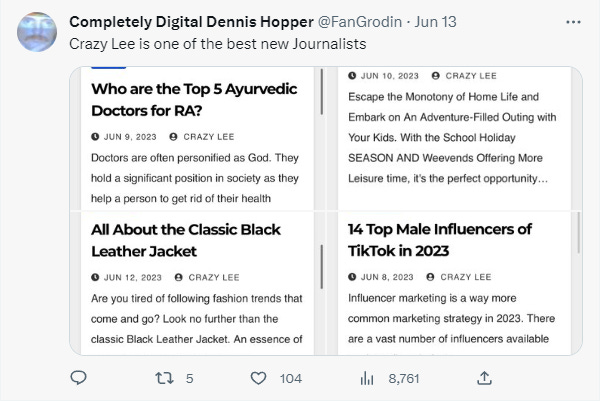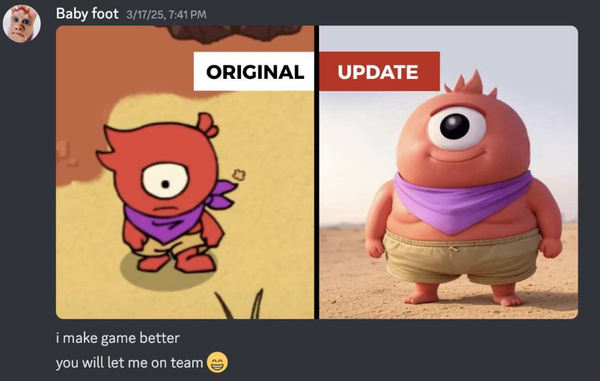A katamari of links
Also: Deepfake John Lennon, AI sludge, and 8 other cultural artifacts worth knowing about.

EX is a research report about contemporary culture. This week: deepfake John Lennon, the main menu of the summer, and 8 other cultural artifacts worth knowing about.
1. AI video sludge is going strong
A lot of AI videos now work like “Duck Story” — they’re comedy sketches that foreground the most cursed output from text-to-video models like Runway and ModelScope. It’s an acquired taste that didn’t exist until recently (“Synthetic Summer” set the standard), but now you can find AI video fans in the comments saluting videos like “Spaced Out” for being good “nightmare fuel,” like “tripping balls,” etc. It’s become obvious to almost everyone that text-to-video is nowhere near ready for prime time, and about all you can generate reliably is disturbing physical comedy. Fortunately, there’s still an audience for that kind of AI sludge — it’s just not as big as the one that was dreaming about, like, infinite Seinfeld episodes.
2. This week in Roblox: Don’t Get Sniffed
This week, big kids’ YouTuber Flamingo played a Roblox game called Don’t Get Sniffed from meme developer Badass Experiences. (They previously made a splash with making memes in your basement at 3 AM tycoon.) In the game, players run from a giant talking nose that murmurs in a deep voice (“I’m gonna sniff ya…I’m gonna sniff you, my friend”) as they try to collect keys and boogers to open doors around the level. It’s a takeoff on Nextbot Chase games, a genre that migrated to Roblox from Garry’s Mod, where oversized .pngs of creepypasta characters and memes chase players around while playing loud soundboard clips. This isn’t exactly a parody of Nextbot games, which were jokey from the start; it’s more just a Nextbot game with a coherent theme. One takeaway here is that horror-comedy — not a staple of traditional kids’ entertainment — has become an undying fascination for Roblox’s youngest players.
3. No, the Beatles are not deepfaking John Lennon
A rush of headlines this week implied that Paul McCartney was wielding the terrible powers of AI to create a ghastly deepfaked John Lennon. (From Popular Science: “New Beatles song to bring John Lennon’s voice back, with a little help from AI.”) Such headlines were repurposed by paid-bluecheck AI boosters (“That’s just a glimpse ✨of how #AI can preserve culture”), aggregated into outraged National Review thinkpieces (“AI cannot replicate John Lennon’s soul”) and endless jokey pisstakes.
Anyway, that’s not what’s happening, here. McCartney’s utilizing some of the same machine learning techniques Peter Jackson used in his film Get Back: as he told the BBC, “They tell the machine, ‘That’s a voice, this is a guitar, lose the guitar.’” In other words, the team’s using machine learning to clean up old audio, isolating Lennon’s vocals such that McCartney can then flesh out the song. While he hasn’t said which song, it’s likely “Now & Then,” a late Lennon solo track from a cassette marked “for Paul” that also included the tracks used in the band’s 1995 “reunion” sessions.
It’s a fine use of the technology but also a case study in the way the term “AI” has become increasingly diluted. The “magic” of generative AI like ChatGPT or Stable Diffusion is increasingly conflated with technologies that have been used with little controversy for years. The nightmare vision — feeding a bunch of John Lennon songs to a machine and asking it to do an impression — isn’t even close to what’s happening here. (Manga fans, however, have reason to ululate.)
4. Final Fantasy XVI demo validates “The Squaresoft Way”
Next week the four-billionth game in the Final Fantasy series will be released, but as a major new numbered installment, FFXVI carries a weight that, say, February’s Theatrhythm Final Bar Line didn’t. This week, developers Square Enix dropped a two-hour demo of the game that folks on YouTube are absolutely flipping out over (“DO NOT SLEEP ON THIS!” “It’s SPECTACULAR” “Best Demo I’ve Ever Played,” etc.). While live-service games regularly get prerelease “betas” that build (or squander) hype weeks in advance, demos of single-player games like this are vestiges of an earlier era, when they were included as pack-in discs alongside magazines or related games. But Square, whose games are typically dozens of hours long, have stuck with the demo format, releasing several-hour samplers (with progress carrying over to the main game) for most of its recent RPGs. None have moved the cultural needle the way FFXVI’s demo has, but it all points to verification that the developer has recaptured its ‘90s mojo by sticking to its guns: high-fantasy, CGI-heavy epics, preceded by a perfectly sliced sampler portion.
5. TikTok is roasting the past
Recently, TikTok users have been careening head-first into memory gulch by digging up cringeworthy trends from 2019 and 2020. From cosplaying theater kids to over-choreographed duets, the common denominator across these trends is that they all bear evidence of TikTok's Musical.ly roots — that is, TikTok's history as an app that exclusively trafficked in lip-syncing videos. While these selections might be carefully curated to surface the cringiest offenders from this era, they still help elucidate the gradual shifts in taste and visual language that have occurred on the platform over the past couple of years. Lip-syncing and dancing remain common TikTok devices, but more vlog-like, casual "slice-of-life" formats have emerged, as well, allowing users to be performative in a way that isn't so straightforwardly theatrical.
6. We do indeed love Katamari
Even though they’d just been served a double-dinner of Tears of the Kingdom followed by Diablo IV, the gaming public still made room for the We Love Katamari remake earlier this month. The Katamari series received a special tribute in the form of a Google Doodle this past week, likely bolstering the remake's popularity. Beyond that stunt, however, the game has something of a special reputation as the second of only two Katamari games to feature involvement from the series' creator, Keita Takahashi. Later games suffered from repetitiveness, diminishing the magic of Takahashi's original and inventive designs, and failed to find ways to develop upon the series' central formula of rolling up a Walmart's worth of colorful, low-poly objects. We Love Katamari, however, captures the series at its most vivid and lively, and its remake demonstrates that the Katamari concept might have been most effectively expressed over the span of one or two well-executed titles.
7. Metaphor ReFantazio’s menus

The most stylish reveal at this year’s Summer Game Fest was Atlus’s long-in-development RPG Metaphor ReFantazio, whose gorgeous animated menus have been circulating on social media ever since. A collage of clashing text and clean character art suspended over a floor of spilled ink, Metaphor’s main menu was the boldest piece of design seen anywhere in the week-long festival of game trailers. The game comes from former members of Atlus’s Persona team, who started turning menus into the ornate centerpieces of their games back in 2006 with Persona 3. As the developers explained in a 2017 talk, the team builds menus and submenus to “convey the identity of the game” through color and movement: Persona 4, for example, had a yellow “pop” aesthetic. Longtime Persona director Katsura Hashino, now the lead on Metaphor, once described the process of fine-tuning Persona 5’s ransom-note UI to make the text less diagonal and “aggressively animated.” Metaphor’s menus look like they haven’t been reined in yet; hopefully they won’t be.
8. “Ballin’” is the latest AI cover trend
Why "Ballin'" specifically, though? We have a couple of hunches: First, "Ballin'" is a track by Mustard and Roddy Ricch, the latter of whom is famous for tracks like "Die Young" and "The Box." "The Box" in particular ascended to viral popularity just as TikTok was becoming a household name, cementing it as a part of the internet's collective unconscious, which may explain why "Ballin'" is a tempting target for memery. However, another potential reason could be found in the musical qualities of the melody itself. Pitch-shifted samples sound less "lifelike" when driven further away from the pitch of the original clip, so it makes sense to channel AI shenanigans through a melody that stays within a fairly limited range and features repetition of the same handful of notes.
9. Fake journo “Crazy Lee” is a content mill god

Twitter user @generalslug uncovered a giant AI content mill that has generated 150,000+ loosely intelligible articles like “How to Build a Helicopter Car at Home.” If you find the text confusing, you can consult the illustrations, which are machine-made diagrams full of wormy text like “Olcthogboth” and “BUSINESS BASINESS.” These are all attributed to authors like “Happy Sharer” and star reporter “Crazy Lee,” whose prodigious output includes many pieces like “5 Things You Can Expect After a Hair Transplant.”
Some game publications are now seeking their own AI wild man, as a recently retracted “AI Editor” job posting for GAMURS Group shows. The posting suggests that the editor will fact-check, rewrite, and add images to “200 to 250” articles weekly, or at least 40 per weekday. There’s obviously a lot of gaming guides material out there to plagiarize, but watch out: as your in-house AI content kings outhustle human writers, they’ll eventually poison the well for future language models trained on internet text. By then, of course, Crazy Lee will be long gone — flying into the sunset in his helicopter car, sporting a luxuriant head of hair.
10. New Amaarae did not have to go this hard
The American-Ghanaian singer Amaarae just dropped her second LP, Fountain Baby, and it is an absolute scorcher, wrangling synth-pop, Caribbean rhythms, pop-punk spunk, and turn-of-the-millennium R&B influences into something singular. Her lilting, often sing-song vocal performances find unlikely pockets in the beats; she flips the Neptunes’ “Wamp Wamp” steel drums, for example, into something that’d do the Thornton brothers proud. Afropop’s a complicated label — attempting, as it does, to compress an entire continent’s popular music into a single genre — but Amaarae seems spiritually kin to artists from Nigeria’s leftfield, post-internet alté scene, which, at its best, creates futurist fantasias as much videogame-soundtrack as party-starter. (Check Cruel Santino’s Final Fantasy-influenced Subaru Boys, from 2022, for a great example thereof.) Fountain Baby’s different only in the supersonic charisma of its creator. As the Clipse would say, “Get familiar.”
That’s it for this week. Hit reply if you want to hire us.





